White Flag Bush
Mussaenda frondosa L.
Rubiaceae
Location in our garden
Principal



Synonym
Gardenia frondosa (L.) Lam.
Mussaenda belilla Buch.-Ham.
Mussaenda dovinia Buch.-Ham.
Habitus
Shrubs. A rounded perennial shrub growing up to 3 m in height.
Part Used
Leaves
Bark
Flowers
Roots
The Whole Plant
Growing Requirements
Full Sunshine
Habitat
Terrestrial
Overview
This plant is native from Cambodia, India, Indonesia, Sri Lanka, and Vietnam. It can be found in wild and collected for its edible leaves and medicinal uses. It is also cultivated as an ornamental in gardens. The leaves and the sepals are eaten as a salad vegetable.
Vernacular Names
Nagaballi (Bengali), Bedina (Hindi), Vellila (Malayam), Velli-matantai (Tamil), Shrivati (Sanskrit), Kingkilaban (Indonesia).
Agroecology
This plant grows well in full to partial sun with neutral, humus-rich, and well-drained soil.
Morphology
- Stems - terete to compressed, moderately to densely pale red sericeous to hirsute becoming glabrescent, red-brown or brown, rather densely lenticellate.
- Leaves - petiole to 1.5 cm long, stipules 3-4 mm long, leaves opposite, densely sericeous, blade drying thinly papery or leathery, adaxially dark green to brownish green, abaxially pale green to yellowed, broadly ovate, 6-10 x 4-6 cm, both surfaces sparsely hairy on lamina, base rounded, caudate acuminate at apex.
- Flowers - 5-merous. Bracts and bracteoles linear, 1-1.5 cm, hairy. Calyx-lobes 5, 0.8-1 cm long, lanceolate, hairy, one of the calyx lobes transformed into a showy, white, pubescent, leaf-like structure, 8-12 x 4.5 cm. Corolla 2.5-3 cm long, funnel-shaped dialated above middle, orange-red or yellow, tomentose outside, villous at mouth; lobes 6-7 mm long, ovate-lanceolate. Stamens 5, included or exserted.
- Fruit – globose, berry 1 cm across.
Cultivation
This plant is cultivated by seeds and cuttings of half-ripe wood.
Chemical Constituents
Quercetin, rutin, hyperin, ferulic acid, sinapic acid and β-sitosterol-glucoside.
Traditional Medicinal Uses
The juice of the plant is used for eye infections and the decoction of the leaves is to get rid of intestinal worms. The juice of the bark is used to treat diarrhoea and dysentery. In Guam, its root is used as a treatment for leprosy. While in Nepal, its juice is used to treat blemishes on the tongue. Moreover, combined with cow's urine, it is used to treat jaundice. The flowers are useful too, they are diuretic and can be used to treat cough.
Part Used
Reference Sources
- Lakshmi, D.K.M., Girija, A.R., Rao, D. V. & Rao, E.V. 1985. Chemical components of Mussaenda frondosa and M. hirsutissima. Indian Journal of Pharmaceutical Sciences. 47(3): 122-123.
- Tropical Plants Database, Ken Fern. tropical.theferns.info. 2021. Mussaenda frondosa. http://tropical.theferns.info/viewtropical.php?id=Mussaenda+frondosa. 23-11-2021.
- Flora of China. Mussaenda frondosa Linnaeus. http://www.efloras.org/florataxon.aspx?flora_id=2&taxon_id=220008890. 23-11-2021.
- India Biodiversity Portal. Mussaenda frondosa L.. https://indiabiodiversity.org/species/show/244652. 23-11-2021.



